![]()
![]()
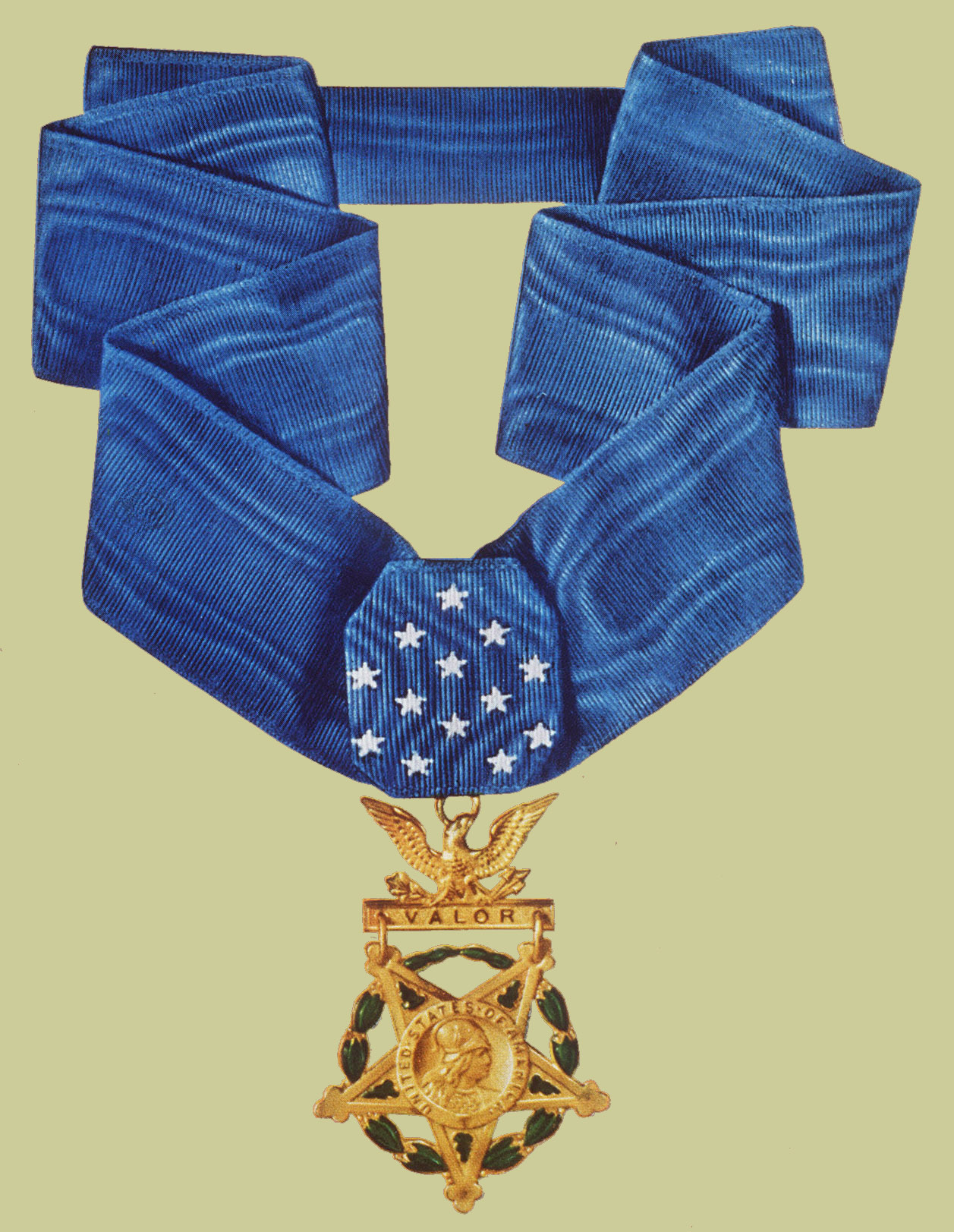 |
|---|
Corps of Engineers Medal of Honor Recipients
![]()
| WILSON, JOHN M. | 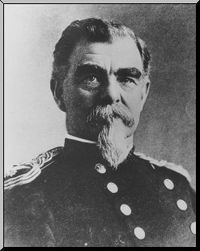 |
First Lieutenant, U.S. Engineers. Topographical Engineers, At Malvern Hill VA, 6 August 1862. Served as Chief of Engineers 1 February 1897 to 30 April 1901, Entered service at: Washington Territory. Birth: Olympia, Washington Territory. Citation Remained on duty, while suffering from an acute illness and very weak, and participated in the action of that date. A few days previous he had been transferred to a staff corps, but preferred to remain until the close of the campaign, taking part in several actions. Wiilson was born in Washington, D.C.. He graduated from the United States Military Academy in 1860 and was commissioned into combined Batteries B & L, 2nd U. S. Artillery as part of the U.S. Horse Artillery Brigade. He transferred to the Corps of Topographical Engineers in July 1862 and was awarded the Medal of Honor for fighting at the Battle of Malvern Hill in Virginia, on August 6, 1862. He joined the United States Army Corps of Engineers in 1863 and received three brevet promotions for gallant service in Alabama. After the Civil War, Wilson worked on Hudson River improvements and drafted plans for the canal around the Cascades of the Columbia River. He improved the Great Lakes harbors of Oswego, New York, Cleveland, Ohio, and Toledo, Ohio. Wilson headed the divisions of the Chief's office pertaining to military affairs for four years, was in charge of public buildings and grounds in Washington during both Grover Cleveland administrations, and was Superintendent of West Point from 1889-1893. Before his appointment as Chief of Engineers, he was Northeast Division Engineer. As Chief of Engineers, he directed the Corps' activities during the Spanish-American War. Wilson retired from the Corps on April 30, 1901. He served as an arbitrator during the Coal Strike of 1902. He remained a prominent figure in the cultural life of Washington until his death there on February 1, 1919 |
|
| GILLESPIE, GEORGE L. | 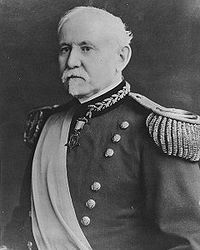 |
First Lieutenant, Corps of Engineers, Near Bethesda Church, VA 31 May 1864. Served as Chief of Engineers 3 May 1901 to 23 June 1904. Born October 7, 1841, in Kingston, Tennessee. He graduated second in the class of 1862 at the United States Military Academy and was commissioned in the Corps of Engineers. Another Southerner who remained loyal to the Union, Gillespie joined the Army of the Potomac in September 1862. He commanded two companies of the engineer battalion which built fortifications and pontoon bridges throughout the Virginia campaigns until the Appomattox surrender. He received the Medal of Honor for carrying dispatches through enemy lines under withering fire to General Sheridan at Cold Harbor, Virginia. He was later Sheridan's Chief Engineer in the Army of the Shenandoah and the Military Division of the Gulf. After the Civil War Gillespie successively supervised the improvement of harbors at Cleveland, Chicago, Boston, and New York. He initiated construction of the canal at the Cascades of the Columbia River and built the famous lighthouse on Tillamook Rock off the Oregon coast. Gillespie also served on the Board of Engineers and for six years as president of the Mississippi River Commission. He commanded the Army's Department of the East in 1898. While Chief of Engineers, he was acting Secretary of War in August 1901. He had charge of ceremonies at President McKinley's funeral and at the laying of the cornerstone of the War College Building in 1903. He served as Army Assistant Chief of Staff in 1904-05 with the rank of major general. General Gillespie retired June 15, 1905, and died September 27, 1913, in Saratoga Springs, New York. |
|
| BENYAURD, WILLIAM H. H. | 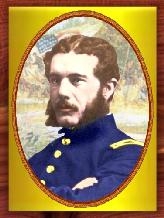 |
First Lieutenant, Corps of Engineers, At Five Forks, VA., 1 April 1865 Entered Service At: Philadelphia, Pa. Birth: Philadelphia, Pa. Citation With one companion, voluntarily advanced in a reconnaissance beyond the skirmishers, where he was exposed to imminent peril; also, in the same battle, rode to the front with the commanding general to encourage wavering troops to resume the advance, which they did successfully. |
|
| GERBER, FREDERICK W. | 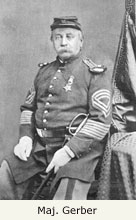 |
Sergeant Major, Corps of Engineers, For Distinguished gallantry in many actions during long faithful and meritorious service over a period of thirty-two years (1839-1871), Birth: Germany. Citation Distinguished gallantry in many actions and in recognition of long, faithful, and meritorious services covering a period of 32 years. Memorialization Gerber Village was named to memorialize Sgt. Maj. Frederick W. Gerber, the first engineer soldier to receive the Medal of Honor. Gerber was born in Dresden, Germany, in 1813. He immigrated to the United States during the 1830s and on Feb. 14, 1839, enlisted in the 4th U.S. Infantry. Gerber took his discharge in 1844, but reenlisted at the beginning of the Mexican War in 1846 as a member of Company A of the Engineers. Gerber is credited most notably with saving the life of (then Lt.) George B. McClellan, an officer in the Engineer Company who later became commander of the Army of the Potomac. Frederick Gerber refused many offers for a commission, preferring instead to remain a non-commissioned officer in the Corps of Engineers. At the beginning of the Civil War, he was appointed acting sergeant major of the Engineer battalion. In June 1864, Congress created the permanent position of sergeant major of the battalion of Engineers, a title which was officially given to Gerber on Jan. 21, 1867, making him the top enlisted man in the Corps of Engineers. Gerber became the first engineer soldier to receive the Medal of Honor, Nov. 8, 1871. His numerous heroic actions throughout his military career make the identification of one specific event or occasion impossible. The citation for his medal reads, "Distinguished gallantry in many actions and in recognition of long, faithful and meritorious services covering a period of 32 years." Sgt. Maj. Gerber died at West Point on Nov. 10, 1875. |
|
| COLYER, WILBUR E. | 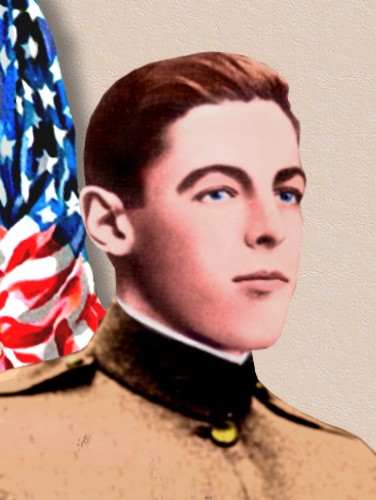 |
Born: March
05, 1898 at Brooklyn, NY, Entered Service in the US Army from South Ozone, NY Sergeant Colyer earned the Medal of Honor for heroism near Verdun, France, during intense assaults upon enemy positions. Volunteering with two other soldiers to locate machinegun nests, Sergeant Colyer advanced on the hostile positions to a point where he was half surrounded by the nests, which were in ambush. He killed the gunner of one gun with a captured German grenade and then turned this gun on the other nests, silencing all of them before he returned to his platoon. He was later killed in action. |
|
| VAN NOY, JUNIOR | |
Private, Headquarters Company, Shore Battalion, 532nd Engineer Boat and Shore Regiment, 2nd Engineer Special Brigade, Near Finschafen, New Guinea, 17 October 1943. Van Noy joined the Army from Preston, Idaho, and by October 17, 1943 was serving as a private in the Headquarters Company of Shore Battalion, Engineer Boat and Shore Regiment. On that day, near Finschafen, New Guinea, he manned a machine gun during an enemy attack, refusing to withdraw even after being seriously wounded. He destroyed half of the small enemy force before being killed. For his actions during the battle, he was posthumously issued the Medal of Honor four months later, on February 26, 1944. Van Noy, aged 19 at his death, was buried at Grace Cemetery in his birth city of Grace, Idaho. Citation For conspicuous gallantry and intrepidity above and beyond the call of duty in action with the enemy near Finschafen, New Guinea, on October 17, 1943. When wounded late in September, Pvt. Van Noy declined evacuation and continued on duty. On October 17, 1943 he was gunner in charge of a machinegun post only 5 yards from the water's edge when the alarm was given that 3 enemy barges loaded with troops were approaching the beach in the early morning darkness. One landing barge was sunk by Allied fire, but the other 2 beached 10 yards from Pvt. Van Noy's emplacement. Despite his exposed position, he poured a withering hail of fire into the debarking enemy troops. His loader was wounded by a grenade and evacuated. Pvt. Van Noy, also grievously wounded, remained at his post, ignoring calls of nearby soldiers urging him to withdraw, and continued to fire with deadly accuracy. He expended every round and was found, covered with wounds dead beside his gun. In this action Pvt. Van Noy killed at least half of the 39 enemy taking part in the landing. His heroic tenacity at the price of his life not only saved the lives of many of his comrades, but enabled them to annihilate the attacking detachment. |
|
| SPECKER, JOE C. | 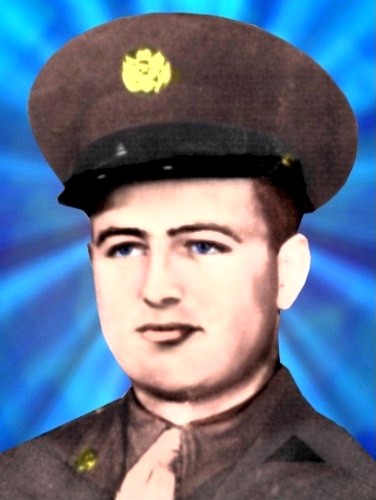 |
Sergeant, U.S. Army, 48th Engineer Combat Battalion, At Mount Porchia, Italy, 7 January 1944. Citation Sergeant Specker, with his company, was advancing up the slope of Mount Porchia, Italy. He was sent forward on reconnaissance and on his return he reported to his company commander the fact that there was an enemy machinegun nest and several well-placed snipers directly in the path and awaiting the company. Sergeant Specker requested and was granted permission to place one of his machineguns in a position near the enemy machinegun. Voluntarily and alone he made his way up the mountain with a machinegun and a box of ammunition. He was observed by the enemy as he walked along and was severely wounded by the deadly fire directed at him. Though so seriously wounded that he was unable to walk, he continued to drag himself over the jagged edges of rock and rough terrain until he reached the position at which he desired to set up his machinegun. He set up the gun so well and fired so accurately that the enemy machine-gun nest was silenced and the remainder of the snipers forced to retire, enabling his platoon to obtain their objective. Sergeant Specker was found dead at his gun. |
|
| KIMBRO, TRUMAN | |
Technician Fourth Grade, Company C, 2nd Engineer Combat Battalion, 2nd Infantry Division, Rocherath, Belgium, 19 December 1944 TRUMAN KIMBRO (? ~ 1944). While Medal of Honor Recipient Truman Kimbro's birth date is unknown; records indicate that he was born in Madisonville, Texas, to Mr. and Mrs. Tom Kimbro. He joined the Army in Houston and after training was assigned as a scout to Company C, 2nd Engineer Combat Battalion, 2nd Infantry Division. By 1944, Kimbro was a Technician Fourth Grade. Citation On December 19, 1944, Kimbro's unit was assigned to mine an important crossroads near Rocherath, Belgium. Kimbro found the crossroads occupied by an enemy tank and 20 infantrymen. After making two attempts to reach his objective and forced to withdraw each time, Kimbro hid his squad and decided to mine the road alone. He was severly wounded while crawling towards the crossroads, but continued to lay his mines. His objective complete, Kimbro attempted to crawl away, but was killed by enemy machine gun fire. The mines he laid helped prevent an enemy attack on withdrawing American columns and for his actions that night Kimbro was posthumously awarded the Congressional Medal of Honor. |
|
| WALLACE, HERMAN C. | 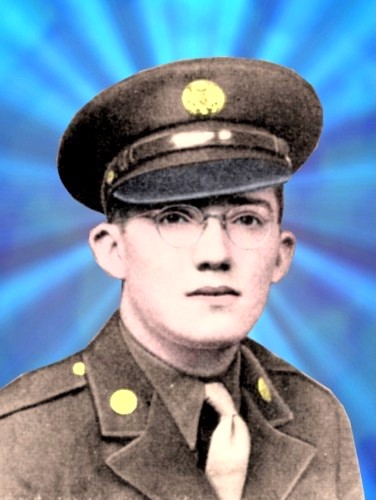 |
Private First Class, Company B, 301st Engineer Combat Battalion,76th Infantry Division, Near Prumzurley, Germany, 27 February 1945 Citation He displayed conspicuous gallantry and intrepidity. While helping clear enemy mines from a road, he stepped on a well-concealed S-type antipersonnel mine. Hearing the characteristic noise indicating that the mine had been activated and, if he stepped aside, would be thrown upward to explode above ground and spray the area with fragments, surely killing 2 comrades directly behind him and endangering other members of his squad, he deliberately placed his other foot on the mine even though his best chance for survival was to fall prone. Pvt. Wallace was killed when the charge detonated, but his supreme heroism at the cost of his life confined the blast to the ground and his own body and saved his fellow soldiers from death or injury. |
|
| LIBBY, GEORGE D. |  |
Sergeant, Company C, 3rd Engineer Combat Battalion, 24th Infantry Division, Near Taejon, Korea, 20 July 1950 Citation Sgt. Libby distinguished himself by conspicuous gallantry and intrepidity above and beyond the call of duty in action. While breaking through an enemy encirclement, the vehicle in which he was riding approached an enemy roadblock and encountered devastating fire which disabled the truck, killing or wounding all the passengers except Sgt. Libby. Taking cover in a ditch Sgt. Libby engaged the enemy and despite the heavy fire crossed the road twice to administer aid to his wounded comrades. He then hailed a passing M-5 artillery tractor and helped the wounded aboard. The enemy directed intense small-arms fire at the driver, and Sgt. Libby, realizing that no one else could operate the vehicle, placed himself between the driver and the enemy thereby shielding him while he returned the fire. During this action he received several wounds in the arms and body. Continuing through the town the tractor made frequent stops and Sgt. Libby helped more wounded aboard. Refusing first aid, he continued to shield the driver and return the fire of the enemy when another roadblock was encountered. Sgt. Libby received additional wounds but held his position until he lost consciousness. Sgt. Libby's sustained, heroic actions enabled his comrades to reach friendly lines. His dauntless courage and gallant self-sacrifice reflect the highest credit upon himself and uphold the esteemed traditions of the U.S. Army. |
|
| BROWN, MELVIN L. | 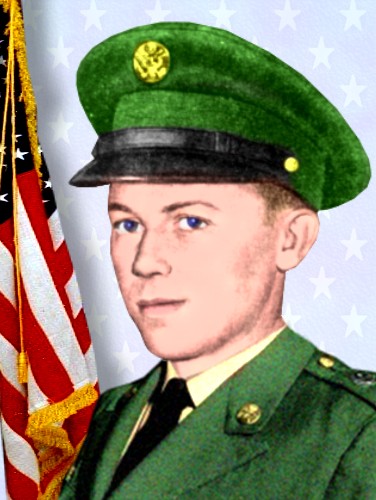 |
Private First Class, Company D, 8th Engineer Combat Battalion, 1st Cavalry Division, Near Kasan, Korea 4 September 1950 Citation Pfc. Brown, Company D distinguished himself by conspicuous gallantry and intrepidity above and beyond the call of duty in action against the enemy. While his platoon was securing Hill 755 (the Walled City), the enemy, using heavy automatic weapons and small arms, counterattacked. Taking a position on a 50-foot-high wall he delivered heavy rifle fire on the enemy. His ammunition was soon expended and although wounded, he remained at his post and threw his few grenades into the attackers causing many casualties. When his supply of grenades was exhausted his comrades from nearby foxholes tossed others to him and he left his position, braving a hail of fire, to retrieve and throw them at the enemy. The attackers continued to assault his position and Pfc. Brown, weaponless, drew his entrenching tool from his pack and calmly waited until they 1 by 1 peered over the wall, delivering each a crushing blow upon the head. Knocking 10 or 12 enemy from the wall, his daring action so inspired his platoon that they repelled the attack and held their position. Pfc. Brown's extraordinary heroism, gallantry, and intrepidity reflect the highest credit upon himself and was in keeping with the honored traditions of the military service. Reportedly missing in action and officially killed in action, September 5, 1950. While his platoon was securing Hill 755 (the Walled City) in Korea, the enemy, using heavy automatic weapons and small arms, counterattacked. Taking a position on a 50-foot-high wall Private First Class Brown delivered heavy rifle fire on the enemy. His ammunition was soon expended and although wounded, he remained at his post and threw his few grenades into the attackers causing many casualties. When his supply of grenades was exhausted his comrades from nearby foxholes tossed others to him and he left his position, braving a hail of fire, to retrieve and throw them at the enemy. The attackers continued to assault his position and Private First Class Brown weaponless, drew his entrenching tool from his pack and calmly waited until they one-by-one peered over the wall, delivering each a crushing blow upon the head. Knocking 10 or 12 enemy from the wall, his daring action so inspired his platoon that they repelled the attack and held their position. |
|
| SCHOONOVER, DAN D. | 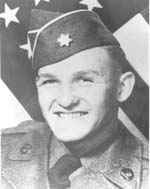 |
Corporal, Company A, 13th Engineer Combat Battalion, 7th Infantry Division, Near Sokkogae, Korea 8 to 10 July 1953 Citation Cpl. Schoonover, distinguished himself by conspicuous gallantry and outstanding courage above and beyond the call of duty in action against the enemy. He was in charge of an engineer demolition squad attached to an infantry company which was committed to dislodge the enemy from a vital hill. Realizing that the heavy fighting and intense enemy fire made it impossible to carry out his mission, he voluntarily employed his unit as a rifle squad and, forging up the steep barren slope, participated in the assault on hostile positions. When an artillery round exploded on the roof of an enemy bunker, he courageously ran forward and leaped into the position, killing 1 hostile infantryman and taking another prisoner. Later in the action, when friendly forces were pinned down by vicious fire from another enemy bunker, he dashed through the hail of fire, hurled grenades in the nearest aperture, then ran to the doorway and emptied his pistol, killing the remainder of the enemy. His brave action neutralized the position and enabled friendly troops to continue their advance to the crest of the hill. When the enemy counterattacked he constantly exposed himself to the heavy bombardment to direct the fire of his men and to call in an effective artillery barrage on hostile forces. Although the company was relieved early the following morning, he voluntarily remained in the area, manned a machinegun for several hours, and subsequently joined another assault on enemy emplacements. When last seen he was operating an automatic rifle with devastating effect until mortally wounded by artillery fire. Cpl. Schoonover's heroic leadership during 2 days of heavy fighting, superb personal bravery, and willing self-sacrifice inspired his comrades and saved many lives, reflecting lasting glory upon himself and upholding the honored traditions of the military service. |
|
| KAWAMURA, TERRY TERUO | 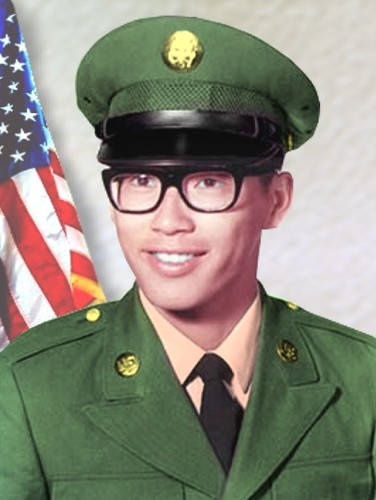 |
Corporal, 173rd Engineer Company, 173rd Airborne Brigade, Camp Radcliff, Republic of Vietnam, 20 March 1969. Citation For conspicuous gallantry and intrepidity in action at the risk of his life above and beyond the call of duty. Cpl. Kawamura distinguished himself by heroic action while serving as a member of the 173d Engineer Company. An enemy demolition team infiltrated the unit quarters area and opened fire with automatic weapons. Disregarding the intense fire, Cpl. Kawamura ran for his weapon. At that moment, a violent explosion tore a hole in the roof and stunned the occupants of the room. Cpl. Kawamura jumped to his feet, secured his weapon and, as he ran toward the door to return the enemy fire, he observed that another explosive charge had been thrown through the hole in the roof to the floor He immediately realized that 2 stunned fellow soldiers were in great peril and shouted a warning. Although in a position to escape, Cpl. Kawamura unhesitatingly wheeled around and threw himself on the charge. In completely disregarding his safety, Cpl. Kawamura prevented serious injury or death to several members of his unit. The extraordinary courage and selflessness displayed by Cpl. Kawamura are in the highest traditions of the military service and reflect great credit upon himself, his unit, and the U.S. Army. |
|
| FREEMAN, ED W. | 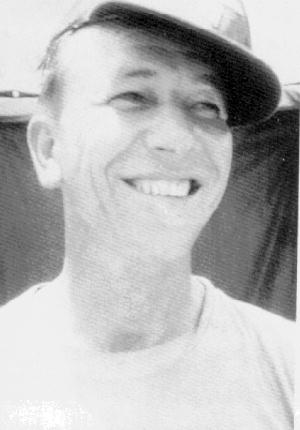 |
Captain, Corps of Engineers, while serving as an aviator with 1st Calvary Division (Airmobile), La Drang Valley, Vietnam, 14 November 1965 Citation For conspicuous gallantry and intrepidity at the risk of his life above and beyond the call of duty. Captain Ed W. Freeman, United States Army, distinguished himself by numerous acts of conspicuous gallantry and extraordinary intrepidity on 14 November, 1965, while serving with Company A, 229th Assault Helicopter Battalion, First Cavalry Division (Airmobile). As a flight leader and second in command of a 16-helicopter lift unit, he supported a heavily engaged American infantry battalion at landing zone X-ray in the Ia Drang Valley, Republic of Vietnam. The infantry unit was almost out of ammunition, after taking some of the heaviest casualties of the war, fighting off a relentless attack from a highly motivated, heavily armed enemy force. When the infantry commander closed the helicopter landing zone, due to intense direct enemy fire, Captain Freeman risked his own life by flying his unarmed helicopter through a gauntlet of enemy fire, time after time, delivering critically needed ammunition, water and medical supplies to the under siege battalion. His flights had a direct impact on the battle's outcome by providing the engaged units with timely supplies of ammunition critical to their survival without which they would almost surely have experienced a much greater loss of life. After medical evacuation helicopters refused to fly into the area, due to intense enemy fire, Captain Freeman flew 14 separate rescue missions, providing life- saving evacuation of an estimates 30 seriously wounded soldiers, some of whom would not have survived, had he not acted. All flights were made into a small emergency landing zone within 100 to 200 meters of the defensive perimeter where heavily committed units were perilously holding off the attacking elements. Captain Freeman's selfless acts of great valor, extraordinary perseverance and intrepidity were far above and beyond the call of duty or mission and set a superb example of leadership and courage for all of his peers. Captain Freeman's extraordinary heroism and devotion to duty are in keeping with the highest traditions of military service and reflect great credit upon himself, his unit and the United States Army. |
|
| CRANDALL, BRUCE P. | 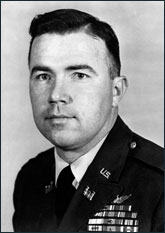 |
Major, Corps of Engineers, while serving as an aviator with 1st Cavalry Division (Airmobile), La Drang Valley, Vietnam, 14 November 1965 Citation Major Bruce P. Crandall distinguished himself by extraordinary heroism as a Flight Commander in the Republic of Vietnam, while serving with Company A, 229th Assault Helicopter Battalion, 1st Cavalry Division (Airmobile). On 14 November 1965, his flight of sixteen helicopters was lifting troops for a search and destroy mission from Plei Me, Vietnam, to Landing Zone X-Ray in the la Drang Valley. On the fourth troop lift, the airlift began to take enemy fire, and by the time the aircraft had refueled and returned for the next troop lift, the enemy had Landing Zone X-Ray targeted. As Major Crandall and the first eight helicopters landed to discharge troops on his fifth troop lift, his unarmed helicopter came under such intense enemy fire that the ground commander ordered the second flight of eight aircraft to abort their mission. As Major Crandall flew back to Plei Me, his base of operations, he determined that the ground commander of the besieged infantry battalion desperately needed more ammunition. Major Crandall then decided to adjust his base of operations to Artillery Firebase Falcon in order to shorten the flight distance to deliver ammunition and evacuate wounded soldiers. While medical evacuation was not his mission, he immediately sought volunteers and with complete disregard for his own personal safety, led the two aircraft to Landing Zone X-Ray. Despite the fact that the landing zone was still under relentless enemy fire, Major Crandall landed and proceeded to supervise the loading of seriously wounded soldiers aboard his aircraft. Major Crandall's voluntary decision to land under the most extreme fire instilled in the other pilots the will and spirit to continue to land their own aircraft, and in the ground forces the realization that they would be re-supplied and that friendly wounded would be promptly evacuated. This greatly enhanced morale and the will to fight at a critical time. After his first medical evacuation, Major Crandall continued to fly into and out of the landing zone throughout the day and into the evening. That day he completed a total of 22 flights, most under intense enemy fire, retiring from the battlefield only after all possible service had been rendered to the Infantry battalion. His actions provided critical resupply of ammunition and evacuation of the wounded. Major Crandall's daring acts of bravery and courage in the face of an overwhelming and determined enemy are in keeping with the highest traditions of the military service and reflect great credit upon himself, his unit, and the United States Army. |
|
| SMITH, PAUL R. |  |
Sergeant First Class, 11th Engineer Battalion, 3rd Infantry Division, Near Baghdad International Airport, Iraq on 4 April 2003 Citation Sergeant First Class Paul R. Smith distinguished himself by acts of gallantry and intrepidity above and beyond the call of duty in action with an armed enemy near Baghdad International Airport, Baghdad, Iraq on 4 April 2003. On that day, Sergeant First Class Smith was engaged in the construction of a prisoner of war holding area when his Task Force was violently attacked by a company-sized enemy force. Realizing the vulnerability of over 100 fellow soldiers, Sergeant First Class Smith quickly organized a hasty defense consisting of two platoons of soldiers, one Bradley Fighting Vehicle and three armored personnel carriers. As the fight developed, Sergeant First Class Smith braved hostile enemy fire to personally engage the enemy with hand grenades and anti-tank weapons, and organized the evacuation of three wounded soldiers from an armored personnel carrier struck by a rocket propelled grenade and a 60mm mortar round. Fearing the enemy would overrun their defenses, Sergeant First Class Smith moved under withering enemy fire to man a .50 caliber machine gun mounted on a damaged armored personnel carrier. In total disregard for his own life, he maintained his exposed position in order to engage the attacking enemy force. During this action, he was mortally wounded. His courageous actions helped defeat the enemy attack, and resulted in as many as 50 enemy soldiers killed, while allowing the safe withdrawal of numerous wounded soldiers. Sergeant First Class Smith’s extraordinary heroism and uncommon valor are in keeping with the highest traditions of the military service and reflect great credit upon himself, the Third Infantry Division “Rock of the Marne,” and the United States Army. |
|
![]()